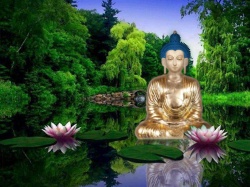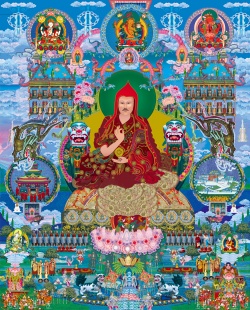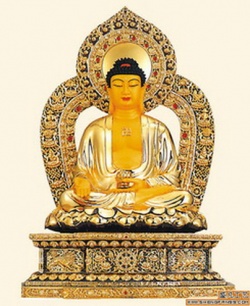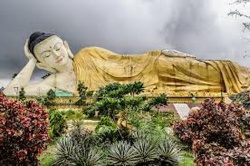An Essay on Tantric Buddhism
by N.K. Singh
Was Tantra originally Brahminical or Buddhist? Before we proceed further, the question whether or not Tantra was introduced in Buddhism as a result of the Brahminical influence may briefly be discussed. According to Austin Waddell Buddhist Tantra is nothing but Shaiva idolatry, Shakti worship and demonology. On the other hand, B Bhattacharya, in his introduction to Buddhist Esoterism, has concluded that the Buddhist were the first to introduce the Tantras into their religion, and that the Hindus borrowed them from the Buddhists in later times.
gopInAtha kavirAja believes that Tantric mantra-shAstra is rooted in Vedic religion. According to G C Pande: “the earliest religion of man was more or less Tantric in nature. He has pointed out that a large number of Tantric elements may be traced in the pre-Buddhist religion in India”. L M Joshi follows him closely. It has rightly been pointed out by modern scholars that the most important aspect of Tantra is the dogma of shaktisAhacharya which has always been closely related with the cult of the Mother Goddess on the one hand and the linga worship and the shaiva cult, on the other. As we have seen, both these elements were present in the Indus religion which consisted of the cult of the Mother Goddess, worship of linga and yoni, the concept of the duality of the Male and Female principles of creation and the practice of Yoga. All these elements were components of an undifferentiated religious and ritualistic complex, which subsequently came to be known as Tantra, already existed, many others were successfully absorbed and some others unsuccessfully tried to become legitimized by the sacred texts. Numerous rituals mainly sexual in character, designed to secure the fertility of fields, are recognized in the Vedas. For them ingenious explanations were offered later on. Practices like mAraNa, vashIkaraNa etc. are distinctly mentioned in the different parts of the Vedic literature. Many of the AtharvaNika practices of witchcraft are almost identical with similar practices of the Tantras.
According to AnAgArika Govinda also, the influence of Tantric Buddhism upon Hinduism was so profound that up to the present day the majority of Western scholars have labored under the impression that Tantra is a Hinduistic creation which was taken over later by more or less decadent Buddhist schools. He asserts: “To declare Buddhist Tantra as an offshoot of Shaivism is only possible for those who have no first-hand knowledge of Tantric literature.”
The manjushrImUlakalpa, possibly the earliest vaipulya sUtra, which contains many elements of the mantrayAna, does not know the third turning of the Wheel of Law, although it is aware of shrIparvata and dhAnyakaTaka as the centers for earliest known Buddhist Tantra. The Tantric Buddhists attribute a number of sAdhanAs and mantras to Gautama Buddha and make a Tantrika of the first order going to the extent that he had discovered himself the great truth that the Buddhahood abides in the female organ and had delivered the secret discourse while enjoying the blissful state with the vajrayoginI. But the tAntric sAdhanAs cannot be regarded as Buddha’s creations or revelations. As pointed out by Wintemitz there is no proof to believe in the existence of Tantras, maNDalas and dhAraNI-s in the age of Buddha. The Buddha discouraged superstition and blind faith and encouraged the spirit of critical enquiry. The kevaTTa sutta shows that he was not in favor of magical and superhuman feats, and regarded these as black arts. In the brahmajAla sutta a long list of pseudo-sciences is given which the Buddha apparently condemned as low arts.
A comparison of the Hindu Tantras with those of Buddhism not only shows an astonishing divergence of methods and aims, in spite of both these views. We feel that the question of the priority of Buddhist Tantra over Brahminical Tantra should not be raised at all because both of them developed concomitantly out of the seeds which are traced to the religious ideas of the pre-Buddhist period.
The first main characteristic feature of Tantric Buddhism is the use of mantras. Actually mantras are so fundamental for Tantric Buddhism that in its primary it is often called mantrayAna. The term mantra means a hymn or prayer sacred to a deity; it is also understood to mean a spell, a charm or an incantation. A mantra is a symbol. This pram symbolizes the prajnApAramitA. A mantra often symbolically represents a deity or even Reality. The manjushrImUlakalpa is full of mantras and their merits. The guhyasamAja and the hevajra-tantra each devote a whole chapter to mantracharyA.
The mantras appear to have developed from dhAraNI-s. The dhAraNI-s are found quoted in several early mahAyAna texts. A number of manuscripts discovered in Gilgit and assignable on paleographical grounds to A.D. five and six centuries, contain dhAraNIs and mantras. The contents of the texts are obviously older than their script. The karaNDavyUha attributes a dhAraNI to the Buddha. The lankAvatAra contains many magical and mystic aspect of the syllables.
Besides the mantras, a vast and varied pantheon is another characteristic feature of Tantric Buddhism. Although the mahAyAnists had been worshipping Buddhas, Bodhisattvas, some demi-gods and a number of deified sages since long, yet the further evolution of a well-classified Buddhist pantheon may well be attributed to the Tantric phase of Buddhism. In the Tantric Buddhist texts is usually given an elaborate discussion on complex liturgy, iconography and theology of the dhyAnI Buddhas (akShobhya, vairochana, amitAbha, ratnasambhava and amoghasiddhi). Each of them is associated with one shakti or female counterpart with a color, a skandha, a vehicle, a particular direction and location in the human body.
The shakti-worship is the raison d’etre of tantra. According to some scholars, the main difference between Brahminical and Buddhist Tantra is that the latter is not Shaktism. The concept of divine power, of the creative female aspect of Shiva, does not play any role in Buddhism. To the Buddhists shakti is mAyA, the illusion from which only prajnA can liberate us. But we fail to agree with this observation. The Buddhists emphasize shakti-sAhacharya as much as the Hindus do, and even believe that the Sakyamuni had himself discovered that the Buddhahood abides in the female and had delivered the secret doctrine while in the blissful state with the vajrayoginI.
In Tantric Buddhism, the supreme Reality is often described as the Unity of prajnA (Wisdom) and upAya (Means); it is the Non-Dual, Two-in-One, the state of final realization. prajnA is the same as shUnyatA (voidness) and upAya is the same as karuNA (compassion); these two terms are very well-known to mahAyAna sUtra. Bodhisattva is the embodiment of both wisdom and compassion; by means of prajnApAramitA or Transcendental Gnosis, he realizes the voidness of the phenomenal things and knows that this samsAra is ephemeral and miserable. Out of karuNA or compassion he endeavors for the salvation of suffering beings.
In Tantric Buddhism nirvANa is envisaged as mahAsukha. That is to say, the ultimate Reality is of the nature of Great Bliss - supreme bliss among all forms of bliss. mahAsukha is the essential nature of the final Truth. It is the state of unity of shUnyatA and karuNA or prajnA and upAya; mahAsukha is prajnopAya, the non-dual fusion of wisdom and means. mahAsukha is the wisdom of all the tathAgatas, and by nature is self-knowable (sva-samvedya). It is described negatively also. Thus Saraha says that mahAsukha is essenceless (niHsvabhAva), indescribable (akatha) and devoid of self and not-self.
Tantric Buddhism assumed several forms and produced several schools. As noted above its earliest stage is usually called mantrayAna. Strictly speaking the mantrayAna concerns itself with mantras and yantras and includes such things as dhAranIs (memorized prayers), mAlA mantras (garland of charms), hrdaya mantras (short charms) etc. It believes that mystic forces are generated by the recitation of mantras and that, with the help of these mystic forces, the worshipper can obtain whatever he desires, such as wealth, victory, siddhis and even mukti.
The yantras are related with mantras because a yantra cannot bestow any power unless the akSharas of appropriate mantras are placed at their appropriate places in it. The AryamanjushrImUlakalpa, the guhyasamAja tantra and the saddharma puNDarIka are full of mantras and dharaNIs and as these were composed in the second or third century A.D. or thereabouts, as a school mantrayAna is regarded as old as the time of nAgArjuna.
In the guhyasamAja, there is an account of the phenomenal world, which is said to have emanated from the original tathAgata. The five skandhas of the early Buddhists, as also the impurities, like rAga, dveSha and moha, are personified as so many Buddhas, issuing out of the original tathAgata. Hence the source of all the buddhas is the vajra, which is identical with shUnyatA or the Reality. But in the vajrayAna, shUnaytA is something positive (which indrabhUti takes as mahAsukha, while anangavajra defines it as prajnopAya). Being characterless, vajra is incapable of leading us to the Truth; therefore from time to time it converts itself into kAya-vAk-chitta-vajra and teaches the way that is vajrayAna (the adamantine or diamond path).
Thus, the vajrayAnists accept the yogAchAra view about the three kAyas of the Buddha and like the mAdhyamikas, identify shUnyatA or vajra with samsAra. The vajrayAna sAdhakas were taught that excreta, urine, etc. are not different from any good food; nor any woman, whether woman or a sister or other’s wife or a girl of low caste, from any other enjoyable woman. Though hideous in many respects, the vajrayAna made many contributions to Buddhism. Some Hindus were also impressed by its doctrines, deities, mantras, sAdhanAs etc. It introduced elements of yoga into ordinary worship, gave a regular system of mantras and produced an exquisite art.
The idea of siddhi (psychic and supernatural power) is common to all Indian religious systems. The Brahminical texts speak of eight siddhis. The Buddhist texts speak of ten kinds of powers (iddhi, rddhi or abhijnA) such as to project mind-made image of oneself, to become invisible, to pass through solid things such as wall, to penetrate solid ground as if it were water, to walk on water, to fly through the air, to touch sun and moon, to ascend into the highest heavens, etc.
The Buddhist Tantrics, who flourished between the eighth and twelfth centuries, developed the theory of eighty-four Siddhas, who had attained supernatural powers through the practice of yoga. The varNAratnAkara of fourteenth century mentions them while the Tibetan sources give a systematic biographical sketch of each of them. According to some scholars, the list of eighty-four siddhas has no historical value. They argue that on account of the mystic implication of the number eighty-four so many names, whether fictitious or historical, have been put together to make up a list. But it is also a fact that many teachers mentioned in this list were actual personages, known in the Buddhist world of those days for their learning and spiritual attainments.
As regards the dates of the various siddhas, the first of them namely Luhi-pa was, in all likelihood, the same as matsyendranAtha of other traditions, who flourished about the beginning of the tenth century A.D. Siddha nAgArjuna lived in the tenth century, as CharpaTi also belonged to about the same time. Tilopa was a contemporary of king mahIpAla I of Bengal (988-1038) and Naropa was his disciple. Jalandhara-pa and Kanho-pa lived also about the middle of the eleventh century. Thus the most famous siddhA chAryas belonged to the tenth and eleventh centuries though some of them probably flourished in the twelfth.
The general trend of the teachings of the siddhA-chAryas was Tantric. Nobody, except a qualified guru was allowed to initiate the disciple in the mysteries of their sAdhanA. The guru had to find out the special spiritual aptitude of the disciple and suggest to him the mode of sAdhanA most suitable for him. Kula symbolized the special spiritual learning of a disciple. There were five such kulas, technically called Dombi, Nati, Rajaki, Chandali and Brahmani. The nature of these kulas was determined by the five skandhas or the essences of the five basic elements (mahAbhUtas). The five kulas are thus five aspects of prajnA. The shakti assumes five different forms according to the predominance of each of the five skandhas.
The Siddha sAdhanA involved the practice of a new form of yoga developed by the siddhAchAryas. According to it, there are thirty-two nerve channels (nADis) within the body. The psychic energy, which has its seat below the nAbhi, flows up into the top-most station within the head called mahAsukhasthAna through these channels. Various names are given to the nADI-s such as lalanA, rasanA, avadhUtI, pravaNA, kTshNarUpiNI, sAmAnyA, pAvakI, sumanA, kAminI etc. There are also a number of other stations, called either lotuses or wheels, within the body. They are compared with the places of pilgrimage like uDDiyAna, jAlandhara, pUrNagiri and kAmarUpa.
The ultimate goal of sAdhanA is the attainment of the state of sahaja which is one of great blissfulness, without beginning and without end, free from duality. In this state the sAdhaka finds himself to be the sole reality, identical with the universe, identical with the Buddha. The attainment of the highest goal also meant certain physical perfections. Therefore a good deal of emphasis was placed on the kAya-sAdhanA involving trans-substantiation of the body.
Later followers of the siddhAchAryas carried it to the extreme and concerned themselves only with the means of attaining a perfect, changeless and imperishable body which would help them to live long. It could be attained in various ways, the most important of them being an upward movement of the bodhichitta (semen virile).
The cultivation of the bodhichitta was related with certain alchemical practices. nAgArjuna was famous for introducing alchemy in matters of sAdhanA. The siddhAchAryas introduced many other innovations in spiritual exercises, but at present it is difficult to follow them on account of the symbolic character of the language in which they are described.
Natha cult derived its inspiration from vajrayAna and the eighty-four siddhas. The propounders of the nAtha school seem to have adopted the teachings of the Buddhist tantras into Hindu thought. Actually tantra proved to be a great synthesizing force and the synthesis of Shaivism and Buddhism is best reflected in the nAtha sect.
The nAthas were originally nine in number. Sometimes they are included in the list of the eighty-four siddhas of the Buddhists. The nAthas introduced many new theories in the sphere of haTha yoga and yoga which were different from those propounded in the Tantras. During the middle of the seventh century nAtha sect became popular through the teaching and mystic songs of the eighty-four siddhas. It travelled to Nepal and Tibet and tantric works were translated into Tibetan. Some of its works also travelled to China and are now found in their Chinese translations.
The vajrayAna also gave rise to several later yAnas such as the sahajayAna and kAlachakrayAna. The sahajayAna is believed to have started with Saraha. By Sahajayana he meant easy path. According to him, perfection can be attained while eating, drinking and merry-making. It implied rejection of religious formalities for attaining nirvANa.
lakShmInkarA devI (729), the sister of King indrabhUti of uDDiyAna, was another famous sahajayAnist. She declared in her advayasiddhi that no suffering, fasting, rites, bathing purification or obedience to the rules of society are necessary for the purpose of obtaining emancipation. It is useless to bow down before the images of gods which are made of wood, stone or mud. The worshipper should offer worship only to his own body where all gods reside. The movement exerted great influence on Vaishnavism also.
The kAlachakrayAna seems to be a later development of the vajrayAna. According to thkAlachakra tantra)] and its commentary vimalaprabhA written by puNDarIka, kAla or time is a phenomenal expression of karuNA and chakra is the world of objects. Kalachakra is a fierce deity, an embodiment of shUnyatA and karuNA, embraced by the shakti or prajnA. Thus kAlachakrayAna represents the philosophical conception of advaya or non-duality, a union of prajnA and upAya.
Kalachakra is regarded as the Adibuddha or the progenitor even of the Buddhas, that is to say, the dhyAni Buddhas. The doctrine that in one’s own body, the whole world is manifest has a resemblance with the doctrines of the sahajayAna and nAtha sects. The system became popular in the eastern and Himalayan regions.





